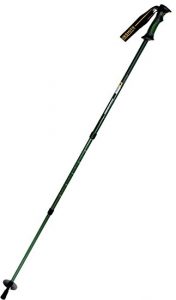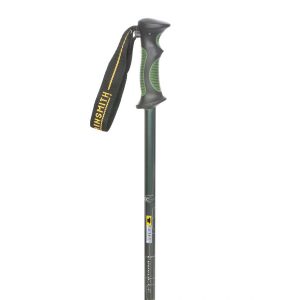I’ve never run with trekking poles, in fact, I don’t even usually hike with them. I have been in races where others are running with them and I often find myself dodging the flailing pointy sticks as they swing erratically behind the person carrying them. My upcoming 100k, however, is going to be run at an elevation that may have snow and will certainly have some slippery trails and steep climbs, and the race director highly recommended using them.
A few years ago I was hiking at Half Dome and I had left my hand carved walking stick at home so I picked up a telescoping trekking pole at the basecamp supply. The base camp store will have exactly what you need at a price you’d rather not pay, but you will because you can’t go anywhere else. Anyway, I used it on the trail that day and I learned a few things. I’ve also watched and talked to those who use them regularly and discovered what they are good for and what they are not good for.
 A few years later I thought I might use them for my second attempt at Euchre Bar Massacre. I had seen Starchy Grant use them there and he never had any of the problems that seem so common with people using them on runs I had seen. I picked up the second pole and decided it should match what I had. I got the Pinnacle by Mountainsmith.They sell for just under $20 each on their website and a little less at Amazon with free shipping, if you have Prime. I ended up not running Euchre Bar that year (or the next), so the poles have been sitting in my garage.
A few years later I thought I might use them for my second attempt at Euchre Bar Massacre. I had seen Starchy Grant use them there and he never had any of the problems that seem so common with people using them on runs I had seen. I picked up the second pole and decided it should match what I had. I got the Pinnacle by Mountainsmith.They sell for just under $20 each on their website and a little less at Amazon with free shipping, if you have Prime. I ended up not running Euchre Bar that year (or the next), so the poles have been sitting in my garage.
When the Loco race director recommended using them I decided I should try them out a little more before then. I took them out on my last 50k race. The race consisted of 3 loops through the start/finish area, so I knew I could drop them off if they bothered me. I ended up running the entire course with them and figured out a few things that I thought I would pass along.
Find a pole that is light and strong and collapsable. There are two types. Foldable poles fit together like a tent pole and have a thin bungee cord running through them. I avoided these because I have seen the cord break and then the pole is useless. Telescoping poles extend and twist to lock. I have a tendency to over tighten these and I had to get used to the amount of tension needed to lock them in place without getting them stuck, making them difficult to collapse. Fortunately, I had worked that out on my Yosemite hike and can now quickly collapse or extend them as needed. These are light and can be attached to a hydration pack or carried at full length without any problem.
Get the pole the correct height for you and for the terrain. In general, the pole handle should be held with your elbows at 90 degrees on flat ground. You might like them a little shorter for steeper terrain. The Pinnacle has 3 sections. Extend the bottom to where it has the “stop” indicator and extend the middle section to the desired height.  It has a measurement scale, so you can note your perfect height when you get it right and don’t have to test it every time.
It has a measurement scale, so you can note your perfect height when you get it right and don’t have to test it every time.
If you’re going to be using them repeatedly throughout the run it is easier to learn to carry them extended than to collapse them and extend them repeatedly. Avoid holding the handles and having the tips stick out behind you and interfere with other runners. Find the balance point on the poles and hold them comfortably as you run. Gripping them tightly will lead to muscle fatigue in your hands and arms. They will rest easily in your hand. If I’m in a group, I reposition my hands slightly so the handles are slightly up and the points point down behind me. With a little practice, switching back and forth from the running to the trekking position became effortless. If you’re going to run for some distance without them it is worth collapsing and strapping to your pack.
I used to snow ski quite a bit and I learned that the poles are an extension of your arms, reaching out with the pole to form a slalom point and ski around it. Trekking is similar. The pole only goes slightly in front of you and plant firmly, but don’t dig in, and move smoothly from right to left in a natural walking rhythm. It’s probably best to not over think it and just let it happen. Your feet and hands (and poles) will sync up to your natural pattern. Try to stay upright. Shorten the poles a bit if the terrain is really steep and the poles force your arms to swing too high.
Besides the (seemingly not so) obvious problem of assaulting runners around you, there are also two other things to avoid. First, while a little pushing is fine, the poles will not hold up to using them “two-fisted” to propel you up a hill, and neither will your arms. I found myself slipping into this from time to time and had to think about it to avoid it. Poles provide balance and stability, they do not provide upward propulsion. Similarly, but different, poles are not designed to support your entire weight. These are rated for about 90 lbs. I saw a friend of mine using his coming down a hill and put his entire weight on it coming around a sharp turn in the trail. The pole snapped and he went face-first down the trail. It was not pretty and damaged his ego more than his face, but not by much.
Here’s a video put out by Mountainsmith that you might find helpful if you are a beginner or considering using poles.
Truth be told, I’m pretty new at this, but I feel pretty confident after running 50k with them. I will likely leave them (and drop them) at a drop bag location for the part of the race I will need them and be free to run the rest unincombered. If any of you experts out there want to add or correct anything, please feel free to comment. Preferably before June 3rd.
